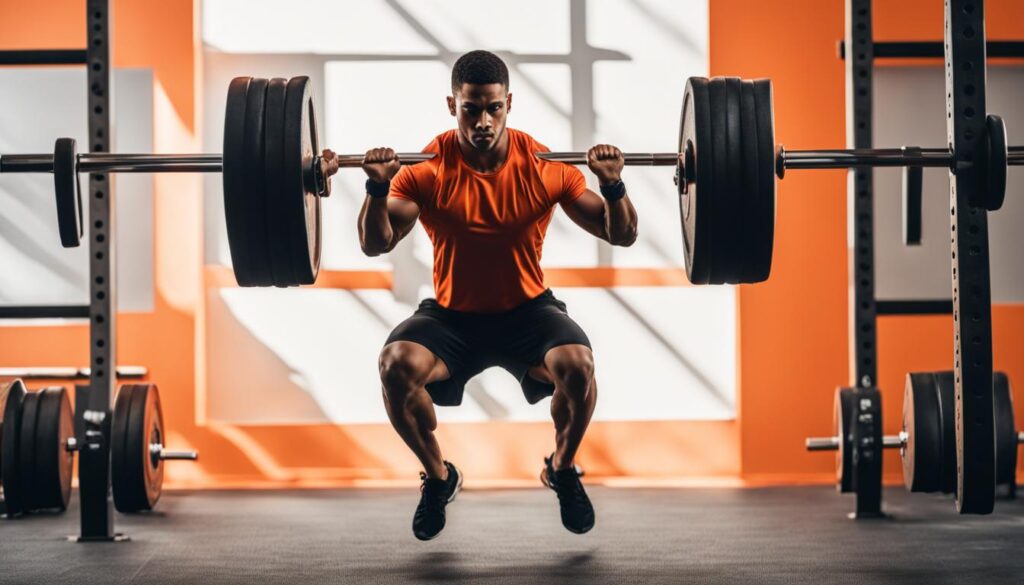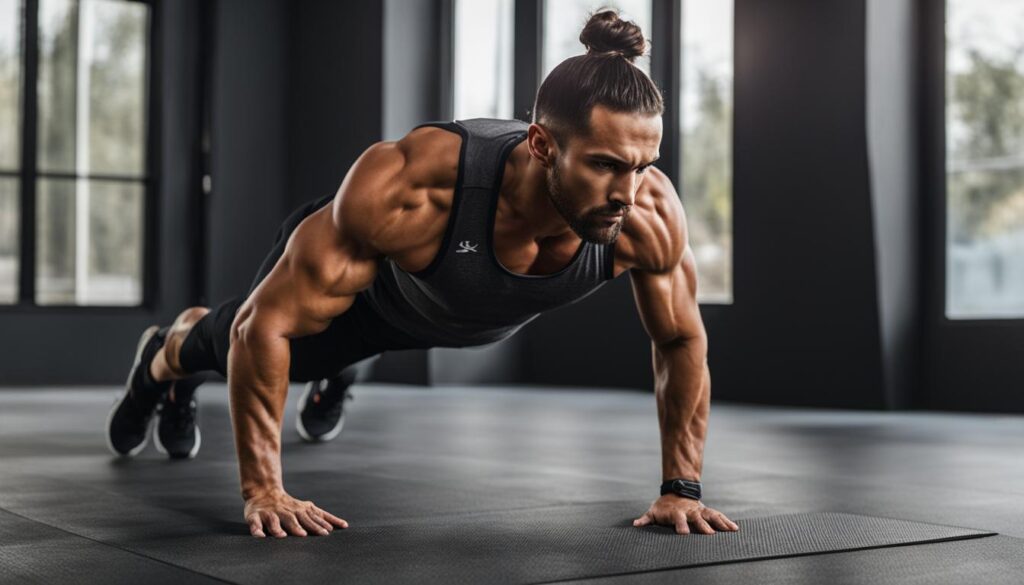Welcome to my article on High-Intensity Interval Training (HIIT) for fat loss. If you’re looking to shed those extra pounds and achieve your weight loss goals, then HIIT workouts may be just what you need. HIIT is a form of exercise that involves short bursts of intense activity followed by periods of rest or low-intensity exercise. This type of workout can help you burn calories, speed up fat loss, and improve your overall fitness in a short amount of time.
With HIIT, you can torch calories and boost your metabolism, even hours after your workout is over. It’s a highly effective method for fat burning because it not only helps you burn more calories during the session but also keeps your body burning calories long after you’ve finished exercising. Additionally, HIIT workouts can help you maintain muscle mass, which is essential for a toned and defined physique.
Not only does HIIT provide great results, but it also offers several other benefits. It improves insulin sensitivity, allowing your body to better regulate blood sugar levels and reduce the risk of developing type 2 diabetes. It also increases post-exercise energy expenditure, leading to greater fat loss. And let’s not forget that HIIT is more enjoyable and time-efficient compared to traditional steady-state cardio exercises.
Key Takeaways:
- HIIT workouts involve short bursts of intense activity followed by periods of rest or low-intensity exercise.
- HIIT helps burn calories and speed up fat loss by boosting your metabolism even after your workout.
- HIIT improves insulin sensitivity and increases post-exercise energy expenditure.
- HIIT is more enjoyable and time-efficient compared to traditional cardio exercises.
- Include HIIT workouts in your fitness routine to achieve your weight loss goals effectively.
Why HIIT is Effective for Weight Loss
High-Intensity Interval Training (HIIT) is a highly effective method for weight loss due to its unique combination of high intensity and short rest intervals. HIIT workouts involve alternating periods of intense exercise with brief recovery periods. This type of training stimulates the metabolism and burns a significant amount of calories, making it ideal for fat loss.
One of the main benefits of HIIT for weight loss is its ability to maintain muscle mass. While steady-state cardio exercises may lead to muscle loss, HIIT workouts help preserve and even build muscle. This is particularly important for individuals looking to improve their body composition and achieve a toned appearance.
Insulin sensitivity is another key aspect of HIIT that contributes to weight loss. HIIT workouts improve insulin sensitivity, allowing the body to more efficiently process glucose and prevent the storage of excess fat. With improved insulin sensitivity, the body becomes more effective at using stored fat as an energy source, ultimately leading to greater fat loss.
Furthermore, HIIT has been shown to increase post-exercise energy expenditure, also known as the afterburn effect. Following a HIIT workout, the body continues to burn calories at an elevated rate for up to 24 hours. This extended calorie burning period further contributes to weight loss and fat burning.
HIIT is especially effective in targeting visceral fat, which is the fat stored around the abdominal area and internal organs. Visceral fat is associated with an increased risk of various diseases, including type 2 diabetes and heart disease. By reducing visceral fat, HIIT workouts can improve overall health and reduce the risk of chronic illnesses.
One of the major advantages of HIIT is its time-efficiency. HIIT workouts are typically shorter in duration compared to traditional cardio exercises, yet they provide comparable or even greater benefits in terms of calorie burn and fat loss. This makes HIIT a practical option for individuals with busy lifestyles who want to maximize their workout results in a limited amount of time.
Another advantage of HIIT is its versatility. HIIT workouts can be tailored to individual fitness levels and preferences, with a wide range of exercises that can be incorporated. From bodyweight exercises to cardio machines to resistance training, there are plenty of options to choose from when designing an effective HIIT routine for fat loss.
Overall, HIIT is an effective and efficient method for weight loss. With its ability to burn calories, maintain muscle mass, improve insulin sensitivity, increase post-exercise energy expenditure, and target visceral fat, HIIT offers a comprehensive approach to achieving fat loss goals. Incorporating HIIT workouts into a well-rounded fitness routine can lead to significant weight loss results.
How to Incorporate HIIT for Weight Loss
To incorporate HIIT for weight loss, it is important to create a calorie deficit through diet. This means consuming fewer calories than your body needs to maintain its current weight. By doing so, your body will start to burn stored fat for energy, resulting in weight loss.
HIIT workouts should be done 2-3 times a week to maximize fat loss and avoid excessive cortisol release. Cortisol is a stress hormone that can lead to weight gain when elevated for prolonged periods. By allowing for proper recovery between sessions, you can optimize the benefits of HIIT while minimizing the risk of overtraining.
In addition to HIIT, it is beneficial to include strength training in your fitness routine. Strength training helps build and preserve muscle mass, which can increase your metabolism and support long-term weight loss.
A well-balanced weekly schedule could include:
- 2-3 HIIT workouts on specific days
- 2-3 strength training sessions
- 1-2 rest days for recovery
Consistency is key when it comes to achieving weight loss results with HIIT. By sticking to a regular workout schedule and making healthy dietary choices, you can effectively incorporate HIIT into your weight loss program.
The Benefits of Incorporating HIIT for Weight Loss
HIIT offers numerous advantages for weight loss:
- Efficient fat burning: HIIT workouts are known for their ability to burn a significant amount of calories in a short period, resulting in fat loss.
- Increased metabolic rate: HIIT can boost your metabolism and keep it elevated even after the workout, allowing your body to continue burning calories throughout the day.
- Preservation of muscle mass: Unlike traditional cardio exercises, HIIT helps maintain muscle mass while primarily targeting fat.
- Improved cardiovascular fitness: Regular participation in HIIT can enhance your cardiovascular health, leading to better endurance and overall fitness.
By incorporating HIIT into your weight loss program, you can enjoy these benefits and achieve your desired results more efficiently.
HIIT vs. Steady Cardio for Fat Loss
| HIIT | Steady Cardio | |
|---|---|---|
| Time Efficiency | Shorter workouts with similar or greater calorie burn | Longer workouts required for similar calorie burn |
| Muscle Preservation | Promotes muscle preservation due to the anaerobic nature of the exercises | Potential muscle loss over time, especially with excessive cardio |
| Metabolic Boost | Increases metabolism, leading to calorie burn even after the workout | Minimal post-workout metabolism boost |
| Variety of Exercises | Allows for a wide range of exercises and intervals, keeping workouts engaging | Repetitive and monotonous exercises |
Does HIIT Burn Stomach Fat?

When it comes to reducing belly fat, many people wonder whether HIIT (High-Intensity Interval Training) can effectively target this specific area. While it is not possible to spot-reduce fat from a particular region of the body, including the stomach, HIIT can contribute to overall weight loss, which includes fat loss in the abdominal area.
Implementing a fat burning HIIT routine can be highly effective in reducing overall body fat, including belly fat. By engaging in high-intensity exercises that elevate the heart rate, HIIT workouts create a calorie deficit and prompt the body to burn stored fat for energy. This can lead to a reduction in overall body fat, including the stubborn fat around the stomach.
In addition to HIIT, it’s important to focus on maintaining a calorie deficit through proper nutrition. A well-balanced diet that includes lean proteins, fiber-rich fruits and vegetables, and healthy fats can support fat loss. Combining HIIT workouts with strength training exercises can also help build lean muscle mass, which can boost metabolism and aid in the reduction of belly fat.
While HIIT can contribute to burning stomach fat, it is crucial to remember that sustainable weight loss requires a combination of regular exercise, a calorie deficit, and a balanced approach to nutrition. HIIT can be a valuable tool in achieving your weight loss goals, but it should be incorporated as part of a comprehensive fitness and lifestyle plan.
| Benefits of HIIT for Belly Fat | Effective Fat Burning Strategies |
|---|---|
|
|
| Things to Consider | Expert Tip |
|
|
How Much HIIT is Too Much?
While HIIT is effective for fat loss, it is important to avoid excessive training. Rest days are necessary for the body to recover and prevent injuries. HIIT workouts should be done 2-3 times a week to avoid prolonged release of cortisol, which can lead to weight gain. It is also recommended to include strength training sessions at least twice a week to build and preserve muscle mass. Balancing HIIT with other forms of exercise is key for sustainable weight loss results.
Hormones play a crucial role in our body’s response to exercise, and cortisol is one such hormone that affects how our body processes stress. HIIT workouts can increase cortisol levels due to the intense nature of the exercises. While cortisol is essential for our body’s functioning, excessive and prolonged release of cortisol can lead to weight gain, particularly around the abdominal area. Therefore, maintaining the right balance of HIIT frequency is crucial for optimizing fat loss and avoiding potential negative effects.
It is generally recommended to incorporate HIIT workouts into your fitness routine 2-3 times a week. These sessions can be alternated with strength training to provide adequate recovery time for muscles and minimize the risk of overtraining. Strength training exercises help build and preserve muscle mass, which is important for long-term fat loss and overall fitness.
“Listen to your body and pay attention to any signs of overtraining, such as excessive fatigue, muscle soreness that lasts for several days, or a decline in performance. These are indications that you may be doing too much HIIT and need to adjust your workout frequency,” advises Dr. Sarah Johnson, a renowned fitness expert and sports medicine specialist.
In addition to HIIT workouts and strength training, it is also essential to incorporate other forms of exercise into your fitness routine. This can include low-impact cardio exercises like walking, swimming, or cycling, as well as activities like yoga or Pilates for flexibility and relaxation. By diversifying your workouts, you not only prevent boredom but also allow your body to adapt and respond to different stimuli, leading to improved overall fitness and better weight loss results.
When it comes to optimizing fat loss, finding the right balance is crucial. While HIIT is an effective tool, overdoing it can have counterproductive effects on your body. By incorporating HIIT workouts into your routine 2-3 times a week, complemented with strength training and other forms of exercise, you can achieve sustainable weight loss while preserving muscle mass and minimizing the risk of overtraining.
10 Minute Low Impact HIIT Workout
A 10-minute low impact HIIT workout can be a great option for beginners or those with joint limitations. This workout includes a variety of exercises that are designed to burn fat and improve cardiovascular health. Let’s take a look at the exercises:
- Squats: Start with your feet shoulder-width apart, lower your body into a squat position, and then stand back up.
- Reverse Lunges: Step back into a lunge position with your right leg, then return to the starting position and repeat with your left leg.
- Inch Worms: Begin in a standing position, bend at the waist and walk your hands out into a plank position, then walk your hands back to your feet and stand up.
- Push-Ups: Get into a plank position with your hands shoulder-width apart, lower your body down to the ground, then push back up.
- Mountain Climbers: Starting in a plank position, bring one knee towards your chest and then switch, alternating between legs.
- Skaters: Leap sideways from one leg to the other, landing on one foot and keeping the opposite leg behind you for balance.
Perform each exercise for 20 seconds with a 10-second rest in between. Repeat the circuit for three rounds to complete the 10-minute workout. Remember to warm up before and cool down after the workout to prevent injury and optimize results.
Sample 10-Minute Low Impact HIIT Workout:
| Exercise | Duration | Rest |
|---|---|---|
| Squats | 20 seconds | 10 seconds |
| Reverse Lunges | 20 seconds | 10 seconds |
| Inch Worms | 20 seconds | 10 seconds |
| Push-Ups | 20 seconds | 10 seconds |
| Mountain Climbers | 20 seconds | 10 seconds |
| Skaters | 20 seconds | 10 seconds |
Remember, it’s important to listen to your body and modify any exercises as needed. This low impact HIIT workout can be a great addition to your fitness routine, providing a quick and effective way to burn fat and improve your overall health.
Can High-Intensity Interval Training and Circuit Training be Combined for Maximum Fat Burning?
Combining high-intensity interval training (HIIT) with circuit training can significantly increase fat burning. HIIT sessions can be incorporated into a circuit training workout to maximize calorie burning and improve cardiovascular health. To burn fat with circuit training, incorporate intense bursts of exercise followed by short rest periods, creating an effective fat-burning workout.
12 Minute Resistance Training HIIT Workout

Looking to build muscle while burning fat? Try this 12-minute resistance training HIIT workout. By combining strength training exercises with high-intensity intervals, you’ll get a full-body workout in a short amount of time.
- Dumbbell Thrusters: Perform for 40 seconds
- Renegade Rows: Perform for 40 seconds
- Overhead Sit-Ups: Perform for 40 seconds
- Bicep Curls: Perform for 40 seconds
- Dumbbell Deadlifts: Perform for 40 seconds
- Squat Holds: Perform for 40 seconds
Rest for 20 seconds between each exercise and repeat the circuit for two rounds. This workout targets multiple muscle groups, helping you build strength and increase your metabolism for fat burning.
Remember to warm up before starting the workout and cool down afterwards to prevent injury and optimize your results. Incorporating this resistance training HIIT workout into your fitness routine will help you achieve your goals efficiently.
Get ready to challenge yourself and see the results of this powerful workout.
| Exercise | Duration |
|---|---|
| Dumbbell Thrusters | 40 seconds |
| Renegade Rows | 40 seconds |
| Overhead Sit-Ups | 40 seconds |
| Bicep Curls | 40 seconds |
| Dumbbell Deadlifts | 40 seconds |
| Squat Holds | 40 seconds |
22 Minute Advanced Bodyweight HIIT Workout

An advanced bodyweight HIIT workout is perfect for fitness enthusiasts seeking a more intense challenge. This workout combines high-intensity exercises with minimal equipment, making it accessible for all fitness levels. Get ready to push your body to its limits and experience the benefits of an advanced bodyweight HIIT workout.
Challenging HIIT Exercises
This workout includes a variety of challenging exercises that target multiple muscle groups and elevate your heart rate. Incorporate these exercises into your routine to maximize calorie burn and improve cardiovascular endurance:
- Pop Squats: Start in a squat position, then explode upwards and land softly back into a squat.
- Plank Jacks: Begin in a high plank position, then jump your feet out and in while maintaining a stable core.
- Tuck Jumps: From a standing position, jump up while tucking your knees to your chest, then land softly.
- Burpees: Begin in a standing position, then drop into a squat, kick your legs back into a plank, perform a push-up, jump your feet forward, and explode into a jump.
| Exercise | Description |
|---|---|
| Pop Squats | Start in a squat position, then explode upwards and land softly back into a squat. |
| Plank Jacks | Begin in a high plank position, then jump your feet out and in while maintaining a stable core. |
| Tuck Jumps | From a standing position, jump up while tucking your knees to your chest, then land softly. |
| Burpees | Begin in a standing position, then drop into a squat, kick your legs back into a plank, perform a push-up, jump your feet forward, and explode into a jump. |
Workout Structure
The advanced bodyweight HIIT workout is designed for maximum efficiency and results. Perform each exercise for 20 seconds with a 10-second jog in between to keep your heart rate elevated. Repeat the circuit for a total of 22 minutes, pushing yourself to maintain proper form and intensity throughout.
Remember to warm up before starting the workout and cool down afterward to prevent injuries and optimize recovery.
Ready to take your fitness to the next level? Challenge yourself with the advanced bodyweight HIIT workout and experience the benefits of high-intensity interval training. Increase your calorie burn, improve cardiovascular endurance, and push your limits like never before.
Conclusion
High-intensity interval training (HIIT) is a highly effective method for achieving fat loss and weight loss goals. The benefits of HIIT workouts are numerous, including increased calorie burn, improved insulin sensitivity, and enhanced cardiovascular health. By incorporating HIIT workouts into your fitness routine 2-3 times a week, along with rest days and strength training, you can optimize your results and achieve your desired weight loss.
Whether you prefer low impact exercises, resistance training, or advanced bodyweight exercises, there is a HIIT workout suitable for individuals of all fitness levels. These different options allow you to tailor your workouts based on your preferences and capabilities, making HIIT accessible to everyone.
One of the greatest advantages of HIIT is its time efficiency. You can achieve significant fat burning and cardiovascular benefits in a shorter amount of time compared to steady-state cardio exercises. This makes HIIT a perfect choice for individuals with busy schedules who are looking to maximize their calorie burn and weight loss results without spending hours in the gym.
In conclusion, incorporating HIIT into your fitness routine is a smart and effective approach to burning fat and achieving your weight loss goals. With its numerous benefits and versatility, HIIT offers a sustainable way to improve your overall health and fitness. So, why not give HIIT a try and experience the incredible results for yourself?




